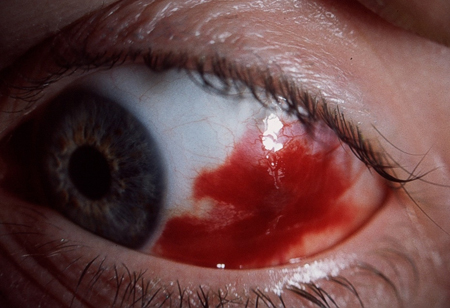Summary
Definition
History and exam
Key diagnostic factors
- hyphaema
- ecchymosis
- severe eye pain
- blurred vision
- corneal abrasions
- corneal oedema
- sub-conjunctival haemorrhages
- corneal and conjunctival lacerations
- punctate epithelial erosions
- loss of sight
Other diagnostic factors
- excessive lacrimation
- conjunctival chemosis
- conjunctival hyperaemia
- corneal epithelial defect/abrasion
- open globe injury
- eyelid burns
- photophobia
- diplopia
- miosis
- corneal stromal clouding
- iridodialysis
- conjunctival foreign body
- corneal foreign body
- Descemet's membrane tears
- corneoscleral lacerations
- persistent headache
- loss of consciousness
- blood or clear fluid from ears or nose
- inability to move eye(s)
Risk factors
- age 18-45 years
- male sex
- no protective eyewear
- workplace injuries
- falls
- fireworks
- exposure to ultraviolet light
- previous eye surgery
- alcohol-based hand sanitisers
Diagnostic investigations
1st investigations to order
- CT scan of orbit
- CT scan of head
- MRI scan of head
Investigations to consider
- plain x-ray
- B-scan ultrasonography
- ultrasound biomicroscopy
- optical coherence tomography
- fluorescein angiography
- fundus autofluorescence
- urine drug screen
- sickle cell trait screen
Treatment algorithm
superficial injuries without a foreign body
hyphaema
corneal abrasion
open globe injury
recurrent corneal erosions or poor healing
Contributors
Authors
Fasika Woreta, MD, MPH
Associate Professor of Ophthalmology
Residency Program Director
Director, Eye Trauma Center
Wilmer Eye Institute
Johns Hopkins University School of Medicine
Baltimore
MD
Disclosures
FW declares that she has no competing interests.
Acknowledgements
Dr Fasika Woreta wishes to gratefully acknowledge Dr Ron Adelman and Dr Elena Raluca Raducu, previous contributors to this topic.
Disclosures
ERR declares that she has no competing interests.
Peer reviewers
Yewlin E. Chee, MD
Assistant Professor of Ophthalmology
University of Washington
Seattle
WA
Disclosures
YE declares that she has no competing interests.
Andrew W. Eller, MD
Professor of Ophthalmology
University of Pittsburgh School of Medicine
Pittsburgh
PA
Disclosures
AE declares that he has no competing interests.
Saloni Kapoor, MD
Clinical Assistant Professor of Medicine
UPMC Mercy Hospital
Pittsburgh
PA
Disclosures
SK declares that she has no competing interests.
Seanna Grob, MD, MAS
Assistant Professor of Ophthalmology
Oculoplastic Surgeon
University of California San Francisco
San Francisco
CA
Disclosures
SG has written a book on ocular trauma.
Peer reviewer acknowledgements
BMJ Best Practice topics are updated on a rolling basis in line with developments in evidence and guidance. The peer reviewers listed here have reviewed the content at least once during the history of the topic.
Disclosures
Peer reviewer affiliations and disclosures pertain to the time of the review.
References
Key articles
Kuhn F, Mester V, Berta A, et al. Epidemiology of severe eye injuries: the United States Eye Injury Registry (USEIR) and the Hungarian Eye Injury Registry (HEIR) [in German]. Ophthalmologe. 1998 May;95(5):332-43. Abstract
Kuhn F, Morris R, Witherspoon CD. Birmingham Eye Trauma Terminology (BETT): terminology and classification of mechanical eye injuries. Ophthalmol Clin North Am. 2002 Jun;15(2):139-43. Abstract
MacEwen CJ. Ocular injuries. J R Coll Surg Edinb. 1999 Oct;44(5):317-23. Abstract
American Academy of Ophthalmology. Policy statement: referral of persons with possible eye diseases or injury. Apr 2014 [internet publication].Full text
Reference articles
A full list of sources referenced in this topic is available to users with access to all of BMJ Best Practice.

Guidelines
- Pediatric eye evaluations preferred practice pattern
- RCH clinical practice guidelines: acute eye injury
More GuidelinesLog in or subscribe to access all of BMJ Best Practice
Use of this content is subject to our disclaimer